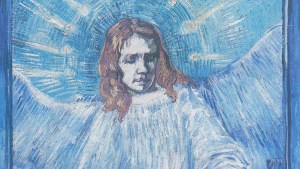A previously unknown self-portrait of Vincent van Gogh has been discovered on the back of another of his paintings. The work, which hid behind van Gogh’s Head of a Peasant Woman for a century, is covered by a cardboard sheet that was glued to the self-portrait. Now experts are trying to find a way to remove the cardboard layer without damaging either artwork.
Discovery
BBC reports that the self-portrait was discovered by the National Galleries of Scotland in an examination prior to a new exhibit at the Royal Scottish Academy, one of several art collections administered by the National Galleries. The canvas was put under an x-ray, at which time the curators could plainly see an unfinished image of Van Gogh from his own hand.
Senior conservator Lesley Stevenson told BBC that the find is significant because it supports what we know about van Gogh’s life and practices. The famed Dutch artist, whose art did not sell well during his lifetime, was known to paint on the back of already used canvases in order to save money on supplies.
History
Head of a Peasant Woman is a painting from the mid-1880s, which features a local woman from the town of Nuenen in the south of the Netherlands. By 1886, the artist had moved to Paris, where he lived for several years and was exposed to French Impressionism, a style which became influential to his works.
It is thought that the self-portrait was painted in Paris and remained uncovered until around 1905, 15 years after the artist’s death. At this point, the painting was loaned to the Stedelijk Museum, in Amsterdam, where it is believed that the canvas was adhered to the cardboard while being framed.
According to CNN, after its display, the painting changed hands several times, until it was acquired by the Scottish National Galleries in 1960. The hidden self-portrait has been in its collection for half a century and no one knew it.
Preservation
The National Galleries of Scotland now has the daunting task of figuring out how to remove the cardboard without damaging either piece. The process of removing the glue between the cardboard and the self-portrait is delicate work that must be undertaken slowly. Conservators are currently conducting research on the process before attempting it on the extremely rare painting.
In the meantime, an x-ray view of the newly discovered van Gogh will go on display. Rather than a print of the x-ray, however, the display will show the genuine painting by using a specially crafted light box that will illuminate the hidden image for viewers. This exhibit will be the focus of a new exhibition titled, “A Taste for Impressionism,” running from July 30 to November 13 at the Royal Scottish Academy in Edinburgh.

